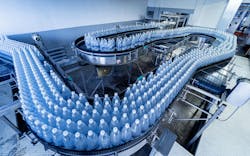I come from an industrial instrumentation and control background, and all my career I have strived to keep the client—namely, the process manager—happy.
Simple rules such as the KISS principle—keep it simple, stupid—and well-maintained, accurately calibrated process measurement and control devices that provide trust have always led me to explore and implement the very latest technologies.
Once you have the trust, then not only the process manager, but everyone right up to the CEO will know that what is being measured and controlled is financially objective. This equates to the most production at minimal cost but with the correct level of quality. Using position sensors in the realm of automation has come a long way in the past decade; so much so, that these are some of the top manufactured automation products in the world.
Position sensors are widely utilized in manufacturing processes to enhance precision, automate tasks and ensure the accurate positioning of components and tools.
Machine tool positioning: In machine-tool applications, linear encoders, rotary encoders and laser displacement sensors are typically found to be the most reliable and accurate. Their application is relatively simple, in that position sensors on machine tools, such as milling machines, lathes and computer numerical control (CNC) machines provide feedback on the position and movement of cutting tools or workpieces. This feedback is crucial for precision machining operations.
Robotics and automated assembly: Robots are becoming highly sought after as they can provide programmable skills in this age of major skill shortages. They comprise encoders, potentiometers and vision systems. They play a key role in the robotic arms and automated assembly lines used in manufacturing. These sensors provide feedback on the position and orientation of robotic joints and end effectors, ensuring accurate and repeatable movements during tasks like pick-and-place, welding or assembly.
Conveyor systems: Many industries employ conveyor systems covering a wide range of types with their respective applications. Typically, these sensors are either photoelectric sensors or ultrasonic sensors. They provide information to detect the presence, position or orientation of products on the conveyor belt. This information is used for sorting, indexing and controlling the flow of materials through the production line.
Quality control and inspection: In industrial quality control, vision systems and laser sensors are used to improve quality by precisely measuring the position and dimensions of manufactured components. Vision systems can identify defects or variations in the position of features, ensuring that products meet quality standards.
Material handling and palletizing: Position sensors play a major role in material handling and palletizing operations by detecting the position of items on pallets or conveyor belts. This information is used to guide automated palletizing systems, ensuring accurate stacking and arrangement of products.
Stamping and pressing operations: Additional applications for position sensors are found in automated or semi-automated stamping and pressing applications. Linear encoders and proximity sensors control the position of the press and the alignment of the material being processed. This contributes to precision in forming and cutting operations.
Packaging machinery: Typically, these applications call for the use of photoelectric sensors and ultrasonic sensors, where the presence and positioning of products on the production line is required. This information is critical for accurate filling, sealing and labelling in packaging machinery.
Coordinate measuring machines (CMMs): Wherever actual sizing or measurements and precise coordinates or locations are needed, linear encoders or laser displacement sensors are typically employed. These sensors ensure accurate and repeatable measurements, contributing to quality assurance in manufacturing.
Die and mold positioning: Position sensors are used in die and mold positioning to ensure precise alignment and movement. This is critical for forming, molding and shaping operations in various manufacturing processes. In these applications, linear encoders and proximity sensors are installed most commonly.
Automated welding: Moving forward to the task of automated welding, encoders and vision systems are employed. These provide feedback on the position of welding torches and workpieces. This ensures accurate and consistent welds, contributing to the quality and efficiency of the welding process.
Renewable energy: We are living in the age of energy transformation and the most installed technology is solar-panel arrays. Position sensors or angular position sensors are used in solar tracking systems to orient solar panels for optimal exposure to sunlight. This helps in maximizing energy capture in solar power generation. Controllers are programmed to make the adjustments to fulfill this requirement.
Electronics manufacturing: Electronic components and systems employ position sensors for pick-and-place machines, circuit board assembly and other precision manufacturing processes.
Mining and construction: Position sensors are used in heavy machinery and equipment to monitor the position of various components, ensuring accurate and safe operation in mining and construction activities.
Structural testing and deformation measurement: In order to measure stress and possible deformation, strain gauges are installed. These sensors are often bonded to the surface of structural components to measure the strain and deformation under load. Changes in electrical resistance of the strain gauges provide information on the structural deformation.
Displacement monitoring: To measure actual position of an item, relative to the requirement, linear variable differential transformers (LVDTs) are commonly used to measure linear displacement. They can be attached to different parts of a structure to monitor its movement under varying loads.
In addition, potentiometers can measure the angular or linear displacement of structural elements. They are often used in conjunction with other instruments to provide accurate position feedback.
Where the rotation of components, such as beams or joints, is to be ascertained, rotary encoders are normally installed. The information they provide is crucial for understanding how different parts of a structure move relative to each other.
Vibration analysis: The measurement of vibration, with its now advanced methodologies, is one of the key parameters in determination of mechanical and electrical equipment longevity. Excess vibration will shorten the life of virtually all pumps, motors and gearboxes. The installation of accelerometers provides this information. However, these sensors do not merely measure vibration, but can also determine the actual position; this is achieved by integrating the acceleration signal over time. This is particularly useful for studying the dynamic behavior and vibrations of structures.
Load and force monitoring: Finally, when it comes to the measurement of applied loads and the forces on a particular piece of equipment, load cells are the natural choice. In addition to measuring loads directly, load cells can be used to infer displacements or deformations by analyzing the applied force and the material properties of the structure.
About the Author

Charles Palmer
Charles Palmer is a process control specialist and lecturer at Charles Palmer Consulting (CPC). Contact him at [email protected].

Leaders relevant to this article:
